LIGHT for Class 7 SCIENCE
INTRODUCTION
Hum apni daily life mein different type ke light sources dekhte hai, eg- sun, electric bulb, torch, etc. Lekin yeh light hoti kya hai? Kaise travel karti hai? Hum objects ko kaise dekh paate hai? Etc. Toh iss chapter mein hum inhi sab baaton ko janege. Iske alawa iss chapter mein hum spherical mirrors ke baare mein janege, lenses se banne wali images ke baare mein janege aur sunlight ke baare mein bhi janege.
Light
Light ek aisa source hai jo khud dikhayi nahi deta aur doosre objects ko dekhne mein hamari help karta hai. Light energy ki hi ek form hai, issi ki wajah se hum objects ko dekh paate hai. Hamare liye sun light ka main natural source hai, iske alawa light ke aur man-made sources bhi hai. Sunlight hamein day-time mein light provide karti hai lekin jab night mein andhera ho jata hai toh hum electric bulbs ki help se light obtain karte hai aur apne aas-paas sabhi cheejo ko dekh paate hai.
Lekin yeh light travel kaise karti hai?
Light Travels Along A Straight Line
Hum sabhi ne bahut se objects/ light sources se light nikalte dekhi hai. Eg- Vehicles aur train ki headlights, torch, searchlights, etc se light nikalte dekhi hogi. Kabhi hum andhere mein torch light on karke bhi dekhte hai toh hum dekh paate hai ki light rays bilkul sidhi jati hai, kahi bhi bend nahi karti, inn sabhi cheejo se hamein pata chalta hai ki light straight line mein travel karti hai. Isko hum ek following activity se bhi samajh sakte hai.Hum ek candle ki light ko dekhne ke liye do different types ke pipe lenge, ek straight pipe aur ek bent pipe. Ab turn by turn dono se candle ki light ko dekhne ki koshish karenge. Hum dekhenge ki straight pipe ke through hum candle ki light ko dekh paa rahe hai lekin bent pipe ke through hum usko nahi dekh paa rahe hai. Iska matlab hai ki light ek straight line mein hi travel karti hai. Ab hum janege ki hum light ka path change kaise kar sakte hai.
Reflection Of Light
Reflection, light ke karan hone wala ek physical phenomena hai, jiske bina hum chijo ko nahi dekh sakte. kyunki object par light aati hai, usse takrati hai aur jis medium se aati hai usi medium me wapas laut jaati hai. Iska matlab hai jab bhi light aakar kisi boundary ya surface se takrati hai aur takra kar usi medium me wapas bounce ho jaati hai ise reflection of light kahte hai.
Definition of Reflection of light - When light ray incident on surface and bounce back in the same medium.
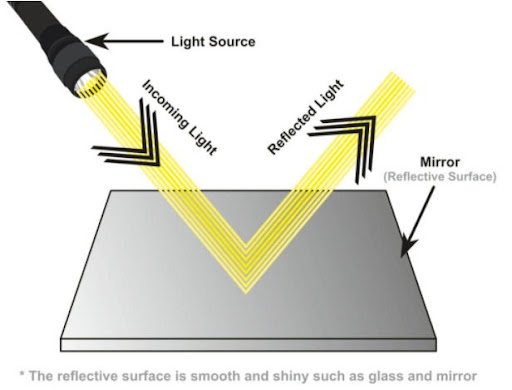
Upar diye gaye figure me dikhaya gya hai ki mirror surface jo ki reflective surface hai. Is surface par torch se incoming light aaker takra rahi hai or takra kar reflect hone ke karan light apna direction change karke usi medium mein wapas laut ja rahi hai jis medium se light aai thi, means light reflect ho rahi hai. Light ka ye phenomenon reflection of light kehlata hai.
Eg- Agar hum ek plane mirror ke samne ek lighted candle rakh de aur mirror mein dekhe toh hamein lagega ki mirror mein bhi same candle rakhi hai lekin mirror ke peeche hamein jo candle dikhayi deti hai woh light ke reflection ki wajah se bani hui image hoti hai aur candle khud ek object hota hai.
Right or Left
Hum jab bhi plane mirror mein apni image dekhte hai toh hamein bilkul same image dikhti hai lekin usme ek difference hota hai jo hum kabhi-kabhi notice nahi karte.
Plane mirror mein jo bhi image banti hai usme right side left appear hoti hai aur left side right appear hoti hai. Isko hum kuchh examples ki help se samajhne ki koshish karenge.
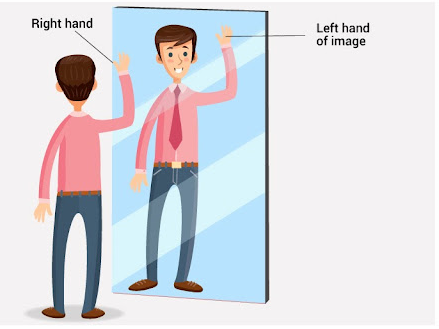

Playing With Spherical Mirrors
A spherical mirror (or curved mirror) is a mirror which has the shape of a piece cut out of a spherical surface.
They are of 2 types: Concave and Convex.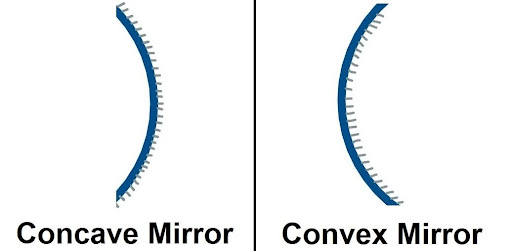
Concave mirror: Agar kisi curved mirror ka outer surface painted hota hai aur inner surface reflecting surface hota hai toh iss type ke spherical mirror ko hum concave mirror kehte hai.
Convex mirror: Agar kisi curved mirror ka inner surface painted hota hai aur outer surface reflecting surface hota hai toh iss type ke spherical mirror ko hum convex mirror kehte hai.
Concave aur convex mirrors ko spherical mirror isliye kaha jata hai kyonki yeh ek hi sphere ke do cut parts hote hai. Concave mirrors ko bahut saare purposes ke liye use kiya jata hai jaise doctors inko eyes, ears, nose aur throat ko examine karne ke liye use karte hai. Dentists bhi teeth ki larger image dekhne ke liye concave mirror ka use karte hai. Convex mirrors ko vehicles mein rear view mirror ki tarah use kiya jata hai aur inko street lamps mein reflectors ki tarah bhi use kiya jata hai.
Spherical mirrors se jo bhi images banti hai woh do type ki hoti hai- Real image and Virtual image.
Real image - It forms when light rays actually meet.
Object se niklne wali rays reflection ke baad jis point par milti hai, agar yeh rays real me milti hai toh jo image form hogi wo real image hogi. Jaisa ki niche diye gaye figure mein dikhaya gaya hai ki kisi flower se rays nikal rahi hai aur yeh incident rays mirror se reflect hoke mirror ke left side pe really mil rahi hai. Is tarah se hamne dekha ki real image kaise form hui.
Ab yeh image aisi hai jo kisi screen par form ho sakti hai. Jaise ki aap movie theatre mein screen par jo movies dekhte hai woh ek real image ka example hai.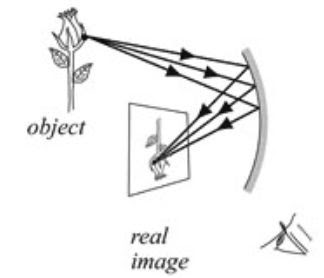
Virtual Image - It forms when light rays appear to meet.
Object se niklne wali rays reflection ke baad jis point par milti hui appear hoti hai, yeh rays real me nahi milti. Isliye in reflected ray ko mirror ke pichhe extend karne par kisi point pe jake milti hai toh uss point par jo image form hogi woh virtual image hogi. Jaisa ki niche diye gaye figure me dikhaya gaya hai ki kisi flower se rays nikal rahi hai or yeh incident rays mirror se reflect hoke mirror ke left side divergent travel kar rahi hai and right side pe virtually kisi point par mil rahi hai. Is tarah se hamne dekha ki virtual image kaise form hui.
Ab yeh image aisi hai jo kisi screen par form nahi ho sakti hai. Jaise ki aap mirror mein khud jab dekhte ho toh wo image virtual image hoti hai.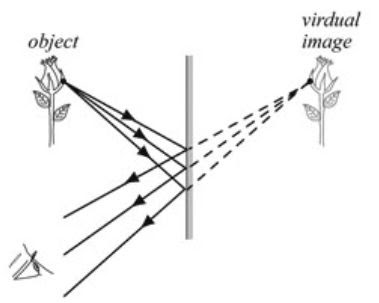
Images Formed By Lenses
Lenses se images kaise banti hai ye janne se pehle hum janege ki lenses kya hote hai? Lens ek transparent glass ka piece hota hai jo apne mein se pass hone wali light rays ko concentrate ya disperse kar deta hai. Lenses ko hum spectacles, telescopes aur microscopes etc. mein use karte hai.Lenses bhi do type ke hote hai- Convex lens aur concave lens.
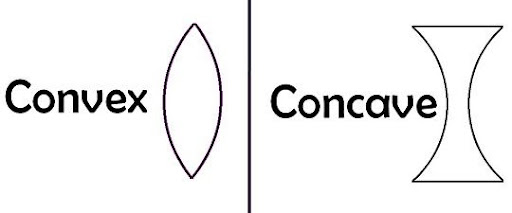
Convex lens: Ek optical lens generally do curved surfaces se mil kar bana hota hai aur agar yeh dono surfaces bahar ki taraf bent hote hai toh isko convex lens kehte hai. Convex lens apne upar padne wali sabhi light rays ko converge kar deta hai isliye isko converging lens bhi kehte hai. Convex lens ko hum touch karke dekhe toh yeh middle mein thick hote hai aur edges par thin hote hai. Convex lens ko magnifying glass ki tarah bhi use kiya jata hai. Convex lens forms a real, inverted and diminished image.
Concave lens: Jab ek optical lens ke dono curved surfaces andar ki taraf bent hote hai toh isko concave lens kehte hai. Convex lens apne upar padne wali sabhi light rays ko diverge kar deta hai isliye isko diverging lens bhi kehte hai. Concave lens ko agar hum touch karke dekhe toh yeh middle mein thin hote hai aur edges par thick hote hai. Concave lens ko hum camera lenses aur binoculars mein bhi use kar sakte hai. Concave lens always forms a virtual, erect and diminished image.
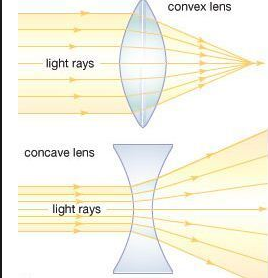
Sunlight- White Or Coloured?
Sunlight ko white light kaha jata hai lekin yeh seven colours se bani hoti hai. This can be observed when a beam of sunlight is passed through a triangular prism or when light falls on a compact disk (CD). Rain ke bad jab rainbow aata hai toh usme bhi hamein seven colours dikhai dete hai. Iske colours easily distinguishable nahi hote. Isme red, orange, yellow, green, blue, indigo aur violet colour hote hai.
Hum soap bubbles ko bhi dhyan se observe karein toh yeh bhi colourful appear hote hai. Ek compact disk se bhi jab light reflect hoti hai toh different colours najar aate hai.
POINT 1
Light: Light is a radiation or a form of energy that our eyes can detect.
Reflection of light: Reflection of light is the simple phenomenon of the light bouncing back after falling on an object.
Virtual image: A virtual image is an upright image that is achieved where the rays seem to diverge.
SUMMARY
1. Light travels along straight lines.
2. Any polished or a shining surface acts as a mirror.
3. An image which can be obtained on a screen is called a real image.
4. An image which cannot be obtained on a screen is called a virtual image.
5. The image formed by a plane mirror is erect. It is virtual and is of the same size as the object. The image is at the same distance behind the mirror as the object is in front of it.
6. In an image formed by a mirror, the left side of the object is seen on the right side in the image, and right side of the object appears to be on the left side in the image.
7. A concave mirror can form a real and inverted image. When the object is placed very close to the mirror, the image formed is virtual, erect and magnified.
8. Image formed by a convex mirror is erect, virtual and smaller in size than the object.
9. A convex lens can form real and inverted image. When the object is placed very close to the lens, the image formed is virtual, erect and magnified. When used to see objects magnified, the convex lens is called a magnifying glass.
10. A concave lens always forms erect, virtual and smaller image than the object.
11. White light is composed of seven colours.